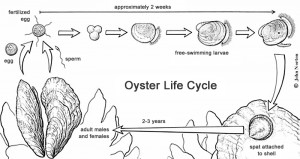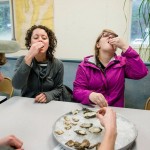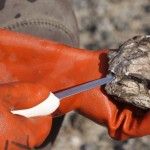The Oyster Life Cycle:
The Oyster life cycle is one highly dependent on the environment; tides, water salinity and temperature. Let us start the life cycle with the time sensitive egg. Fertilized eggs cannot exist without both egg and sperm. The eggs and sperm will encounter each other in the water, begin the fertilization process, and drift away from the spawning grounds in the water currents. Fertilized eggs drift in the water column undergoing cell division until they become juvenile larvae. Oyster larvae will live in the water column for the next two weeks maturing through different stages. Larvae swim in the water currents in order to follow the phytoplankton, their source of food. Larvae are not capable of swimming horizontally, but they can move vertically to some extent. Once the larvae are approximately two weeks old and in the pediveliger stage (larva with a foot), they begin to concentrate at the bottom of the river system to search for a hard substrate. The larvae utilize an appendage that they grow called a foot. This foot helps them crawl around on the bottom to find a suitable substrate for them to attach to. Once they have successfully located a suitable location, usually an oyster shell, they begin to attach to the shell by secreting a glue. The larvae then undergo a complete metamorphosis of internal anatomy and become what we call a spat.
The oyster spat will start to feed and put all of their energy into shell growth by sequestering calcium carbonate from the water column. The oyster becomes a juvenile at one year of age, and officially becomes an adult at year three. Oysters typically grow up to an inch per year. This is dependent on salinity and the quality of the water column. In higher salinity areas, oyster will grow faster than in lower salinity areas.
Most oysters have reached prime spawning size by the time they are three years old. There are many factors that can impact successful oyster spawning. In order for an oyster to spawn, they must eat naturally occurring phytoplankton in the water column and use that energy and invest it into creating a gonad, which will be either eggs or sperm. An oyster uses environmental cues to begin the ripening process in the early spring. An increase in water temperature, coupled with an increase/decrease in salinity or a change in the phytoplankton biomass usually stimulates the oyster to begin putting on gonad. This process can take up to 2 months in the spring.
Once adult oysters are ripe they can begin to spawn. Environmental cues fuel the spawning process with oysters preferring to spawn at water temperatures between 20°C to 30°C (74°F to 86°F) and at salinity above 10ppt. It only takes one oyster to release its gonad to encourage other oysters to commence spawning. For example, if a male oyster starts to spawn by releasing his gonad into the water column, the oysters surrounding him will filter in some of this sperm. Once the other oysters detect the presence of sperm in the water, they will begin to release their own gonad to ensure successful reproduction.







Leave a Reply